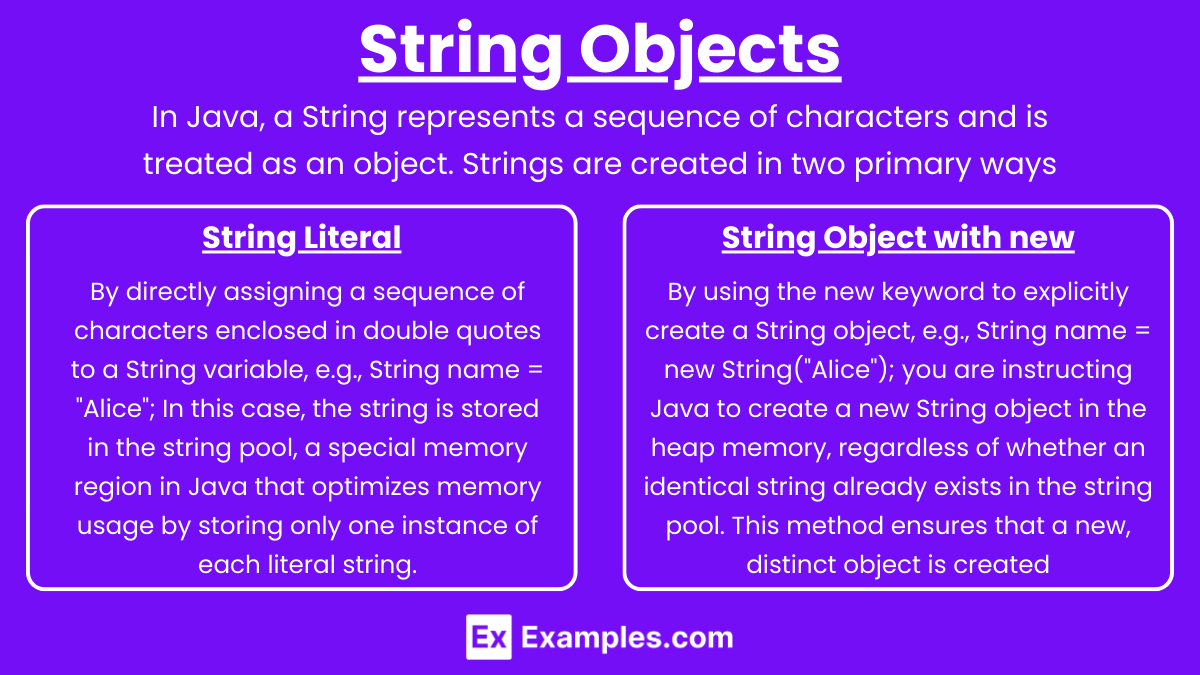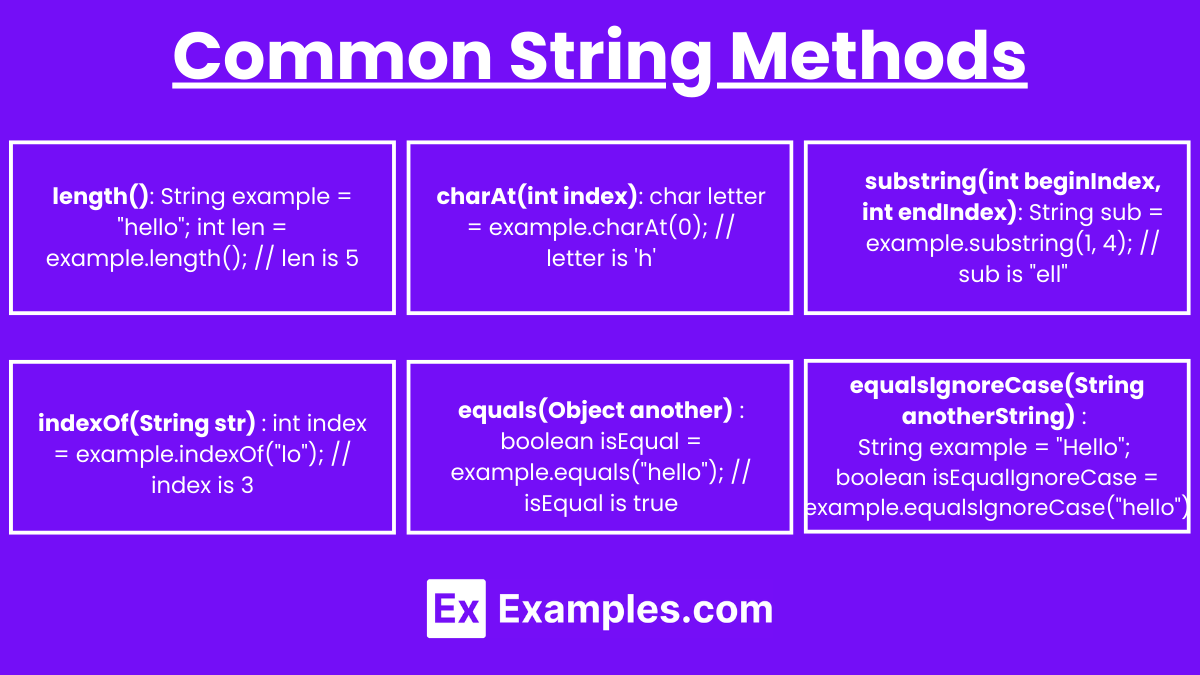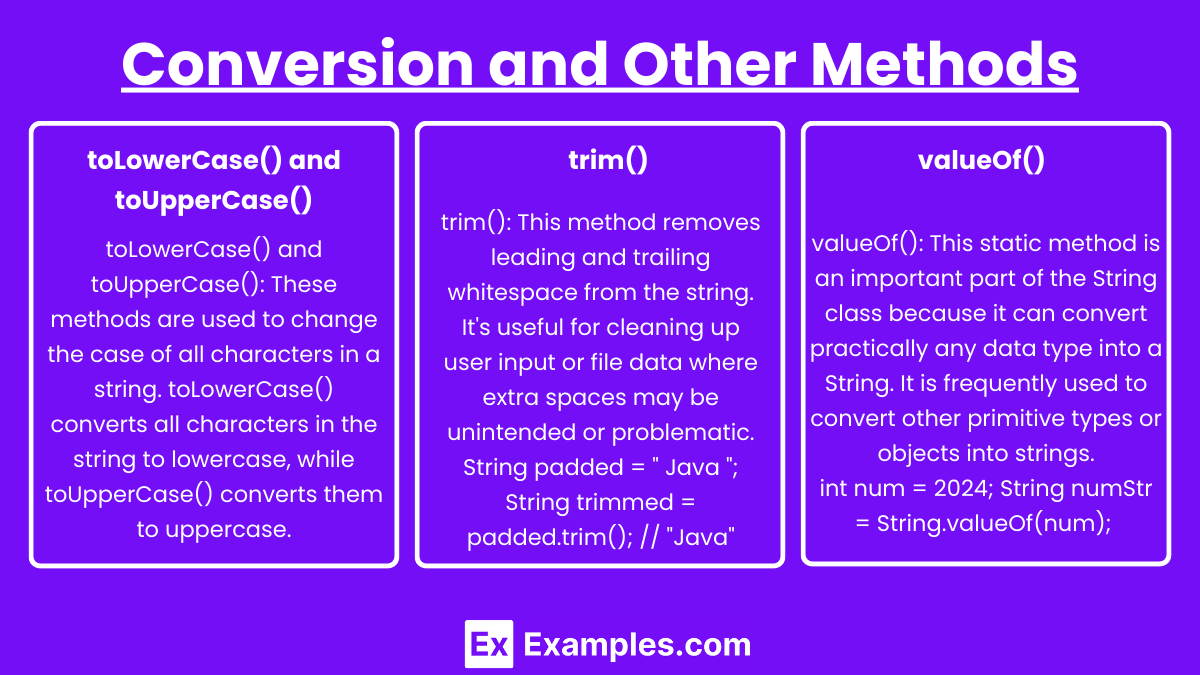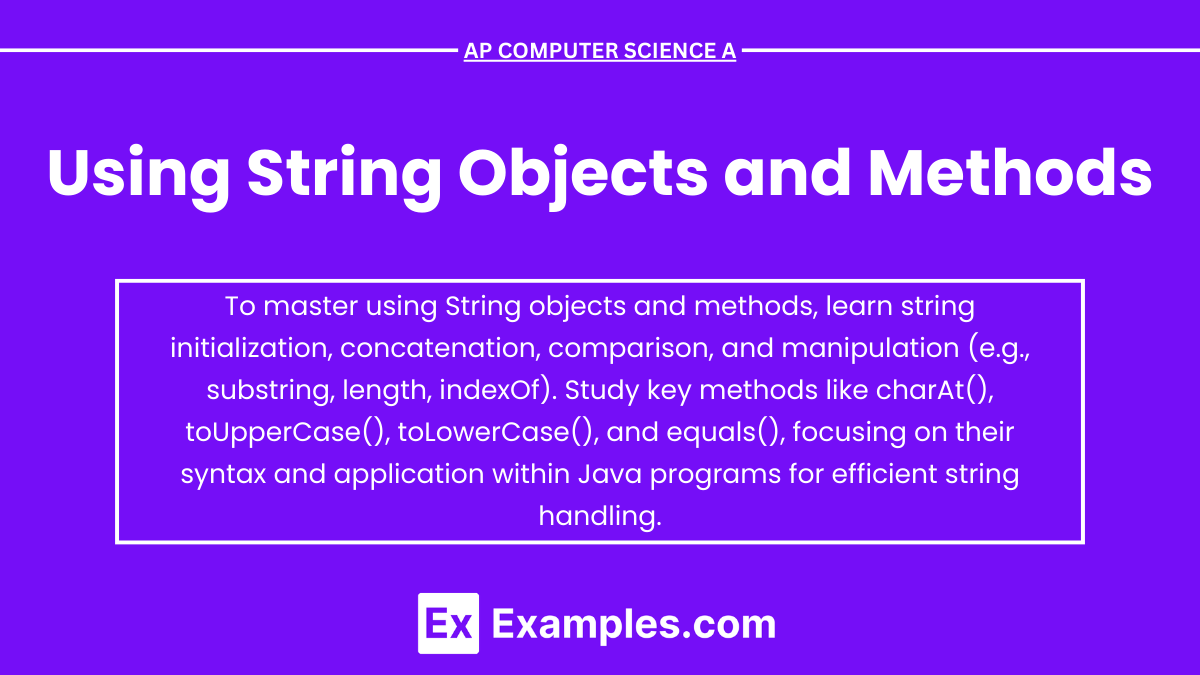In AP Computer Science A, a fundamental topic is the utilization of String objects and methods. Strings, sequences of characters, are central to Java programming. Key aspects include creating strings, understanding their immutable nature, and utilizing various methods for manipulation such as ‘ substring ‘, ‘ indexOf ‘, and ‘ length ‘. Mastering these enables effective data processing and manipulation, essential for solving real-world problems. This topic also delves into string comparison, conversion, and the significance of string immutability, preparing students for advanced programming tasks.
Learning Objectives
For the AP Computer Science A topic “Using String Objects and Methods,” the learning objectives include mastering the creation and manipulation of strings in Java, understanding and applying string methods like ‘ substring ‘, ‘ charAt ‘, and ‘ trim ‘. Students should also learn to compare strings using equals and ‘ compareTo ‘, handle string immutability, and perform conversions with ‘ valueOf ‘. Additionally, objectives cover efficient string concatenation techniques and the impact of string methods on memory and performance, crucial for developing robust Java applications.
String Objects

In Java, a String represents a sequence of characters and is treated as an object. Strings are created in two primary ways:
- String Literal: By directly assigning a sequence of characters enclosed in double quotes to a String variable, e.g., String name = “Alice”; In this case, the string is stored in the string pool, a special memory region in Java that optimizes memory usage by storing only one instance of each literal string. If another string with the same content is created using a literal, Java points to the existing string in the pool rather than creating a new object.
- String Object with new: By using the new keyword to explicitly create a String object, e.g., String name = new String(“Alice”); you are instructing Java to create a new String object in the heap memory, regardless of whether an identical string already exists in the string pool. This method ensures that a new, distinct object is created, which can be useful in scenarios where object identity is important. However, it is generally less efficient than using string literals because it bypasses the string pool, leading to increased memory usage.
Immutability of Strings
Strings in Java are immutable, which means once a String object is created, its value cannot be changed. Any operation that appears to modify a String actually creates a new String object.
Common String Methods

Understanding and utilizing String methods are key in manipulation and operation. Here are some commonly used methods:
length(): Returns the length of the string.
String example = "hello";
int len = example.length(); // len is 5charAt(int index): Returns the character at the specified index.
char letter = example.charAt(0); // letter is 'h'substring(int beginIndex, int endIndex): Returns a new string that is a substring of this string.
String sub = example.substring(1, 4); // sub is "ell"indexOf(String str): Returns the index of the first occurrence of the specified substring.
int index = example.indexOf("lo"); // index is 3equals(Object another): Compares this string to the specified object.
boolean isEqual = example.equals("hello"); // isEqual is trueequalsIgnoreCase(String anotherString): Compares this String to another String, ignoring case considerations.
String example = "Hello";
boolean isEqualIgnoreCase = example.equalsIgnoreCase("hello"); // isEqualIgnoreCase is trueConversion and Other Methods

- toLowerCase() and toUpperCase(): These methods are used to change the case of all characters in a string. toLowerCase() converts all characters in the string to lowercase, while toUpperCase() converts them to uppercase. This is particularly useful in scenarios where case-insensitive comparisons are necessary.
String mixed = "Java Programming";
String lower = mixed.toLowerCase(); // "java programming"
String upper = mixed.toUpperCase(); // "JAVA PROGRAMMING"- trim(): This method removes leading and trailing whitespace from the string. It’s useful for cleaning up user input or file data where extra spaces may be unintended or problematic.
String padded = " Java ";
String trimmed = padded.trim(); // "Java"- valueOf(): This static method is an important part of the String class because it can convert practically any data type into a String. It is frequently used to convert other primitive types or objects into strings.
int num = 2024;
String numStr = String.valueOf(num); // "2024"Examples
Example 1: Concatenation and toUpperCase() Method
Concatenation is frequently used to combine strings for creating messages or processing user inputs. Additionally, converting a string to uppercase can be particularly useful for displaying standardized messages or ensuring case-insensitive comparisons.
String firstName = "Alice";
String lastName = "Smith";
String fullName = firstName + " " + lastName; // Concatenation
String shoutOut = fullName.toUpperCase(); // "ALICE SMITH"Here, ‘ fullName ‘ combines ‘ firstName ‘ and ‘ lastName ‘ with a space in between, and ‘ shoutOut ‘ is the uppercase version of ‘fullName ‘, useful in scenarios where uniform formatting is needed.
Example 2: Using trim() and split() Methods
These methods are very useful for processing formatted inputs or data extracted from files. trim() helps remove any unintended whitespace, and split() can divide a string into an array based on a specified delimiter.
String data = " red, green, blue, yellow ";
String trimmedData = data.trim(); // Removes leading and trailing spaces
String[] colors = trimmedData.split(", "); // Splits the string into an arrayThis example first trims the ‘ data ‘ string to remove unnecessary spaces and then splits it into an array ‘ colors ‘, where each element is a color name.
Example 3: Finding a Character with charAt() and Checking Substring with contains()
The charAt() method allows you to retrieve a specific character by its index, and contains() checks if a certain substring is present within the string.
String sentence = "Hello, world!";
char fifthChar = sentence.charAt(4); // 'o'
boolean hasWorld = sentence.contains("world"); // trueIn this snippet, fifthChar retrieves the character at index 4 from sentence, and hasWorld verifies if the substring “world” exists within the string.
Example 4: Comparing Strings Using equals()
This method is crucial for comparing the content of two strings, ensuring that the comparison is case-sensitive, which is critical in situations where exact matches are required.
String original = "hello";
String input = "Hello";
boolean isEqual = original.equals(input); // false
boolean isEqualIgnoreCase = original.equalsIgnoreCase(input); // trueHere, ‘ isEqual ‘ checks for a case-sensitive match which returns false, while ‘ isEqualIgnoreCase ‘ ignores case, returning true, showcasing flexible comparison options.
Example 5: String Conversion with valueOf()
This static method of the String class is highly useful for converting other data types to strings, which is essential for outputting numbers or other data as part of a text.
int year = 2024;
String yearString = String.valueOf(year); // "2024"yearString converts the integer year to a string, allowing it to be easily incorporated into text-based interfaces or logs.
Multiple Choice Questions
Question 1
What will the output be when the following code is executed?
String str = "Java";
String anotherStr = str.concat(" Programming");
System.out.println(anotherStr);A) ‘ Java ‘
B) ‘ Programming ‘
C) ‘ Java Programming ‘
D) ‘ null ‘
Correct Answer: C) Java Programming
Explanation: The concat method appends the string ” Programming” to the string str which contains “Java”. The result is “Java Programming”, which is stored in anotherStr. When anotherStr is printed, it outputs “Java Programming”.
Question 2
Which method call will return ‘ true ‘ for the string ‘ String example = “HELLO”; ‘ when checking if it contains the substring ‘ “hello” ‘ in a case-insensitive manner?
A) ‘ example.contains(“hello”) ‘
B) ‘ example.equalsIgnoreCase(“hello”) ‘
C) ‘ example.toLowerCase().contains(“hello”) ‘
D) ‘ example.toUpperCase().equals(“HELLO”) ‘
Correct Answer: ‘ C) example.toLowerCase().contains(“hello”) ‘
Explanation: Option A will return false because contains is case-sensitive. Option B is incorrect because equalsIgnoreCase compares the entire string, not a substring. Option D is also incorrect because it uses equals, which compares the whole string, not whether it contains a substring. The correct method is option C, where example.toLowerCase() converts HELLO to hello, and then contains(“hello”) checks if the substring “hello” is present, which it is.
Question 3
Consider the following code snippet:
String s1 = "Java";
String s2 = new String("Java");
boolean result = s1 == s2;
System.out.println(result);What is the output of this code?
A) true
B) false
C) An error occurs
D) None of the above
Correct Answer: B) false
Explanation: In Java, using ‘ == ‘ to compare strings compares their references, not their actual contents. In this code, s1 refers to a string literal in the string pool, while ‘ s2 ‘ is a new string object created in the heap. Despite both strings containing the same characters, their references are different, hence ‘ s1 == s2 ‘ results in ‘ false ‘. If ‘ .equals() ‘ were used, it would compare the contents and return ‘ true ‘.


